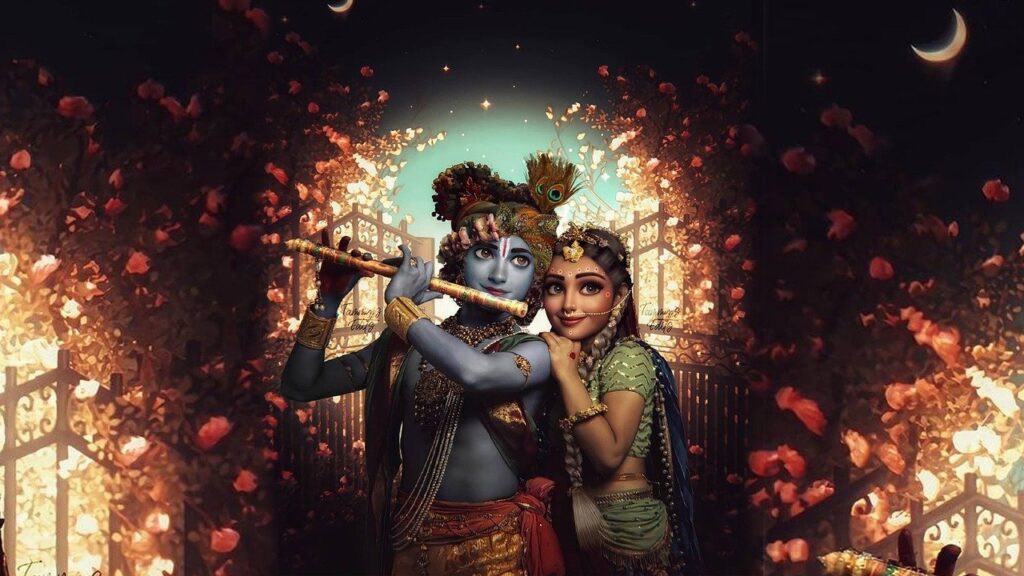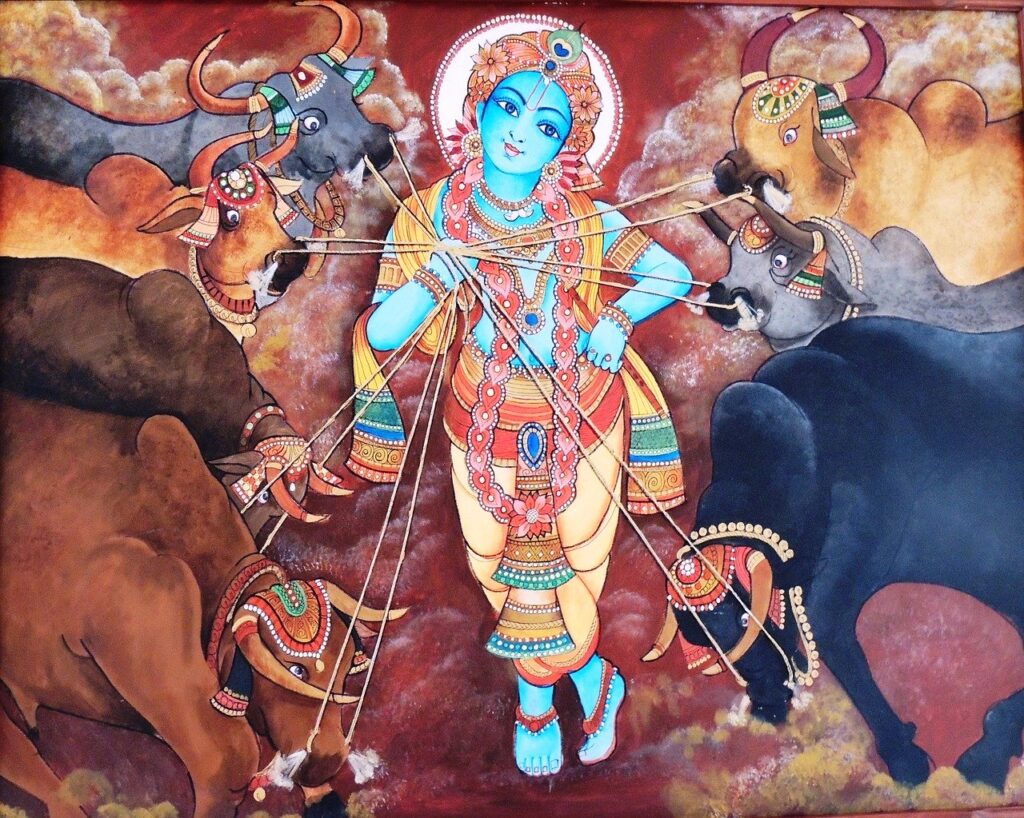
Srimad Bhagavatam reveals that Lord Shiva is the foremost of all the Vaishnavas (devotees of Vishnu) – ‘vaishnavanam yatha sambhuh purananam idam tatha’ (Srimad Bhagavatam – 12.13.16). However, some people having incorrect sambandha gyan (knowledge of relationship with the Supreme) incorrectly claim that Lord Shiva is the Supreme Lord. The scriptures, however, unambiguously reveal that Lord Shiva is a devotee of the Supreme Lord and in fact he is a devotee of the highest order. The Mohini Murti pastime, wherein Lord Shiva was bewildered by Krishna who took the form of a beautiful attractive woman, or the pastime of Bhasmasura , wherein Lord Shiva had to flee from the asura unto whom he had bestowed several benedictions a while before, reflect the superiority and the position of Lord Krishna as the Supreme.
In fact, Shiva is always meditating and hankering to render service unto Sri Krishna who is his dear beloved Lord. In Chaitanya Mangala, it is described how Lord Shiva once became mad with ecstasy after honoring a tiny morsel of Krishna Prasadam which he had received from Narada Muni. Such were his feelings, that he began loudly singing and dancing. The dance slowly became more and more vigorous and took the shape of ‘Tandava’, a dance that is usually performed at the time of annihilation. As the whole world started shaking, the helpless demigods approached mother Parvati requesting her to console her husband. We can thus clearly understand how dear Krishna and His food remnants are to Lord Shiva.
Mahesh kahoye shuno ananda kahini
Prabhura prasad more dila mahamuni
Durlabha e trijagate vishnu nibedita
Vishesh adharamrita vede abidita
(Chaitanya mangala)Translation –
Lord Shiva replied to devi Parvati, “Please listen to this blissful news. The great sage Narada has brought me the food remnants of Lord Vishnu. Lord Vishnu’s remnants are inconceivably rare in these three worlds. It is the nectar touched by the Lord’s lips. Even the Vedas do not know the end of glories of Lord Vishnu’s Mahaprasadam”
On another occasion, Shiva ,being attracted to the Lord’s rasa lila, took the form of a Gopi, to serve and participate in the Lord’s rasa pastimes. As a result Shiva is also worshiped as Gopeshwar Mahadeva in Vrindavana, where he, serving as the gatekeeper, protects the Rasa mandali (the site of the Rasas) and bestows Krishna prema (love unto Krishna) unto his worshippers. Every evening this deity of Gopeshwar Mahadeva (Shiva dressed as a Gopi) is decorated as a beautiful Gopi to commemorate his desire to participate in the Rasa pastimes of Lord Krishna.

Lord Shiva is also the original spiritual master of a bonafide Vaishnava disciplic succession , known as the ‘Rudra sampradaya’. The succession has been named after him. Sri Vishnuswami, the founding acharya of this sampradaya, received this supreme knowledge of Krishna consciousness (devotion unto Krishna) from the greatest Vaishnava, Lord Shiva himself.Its adherents say that ultimate liberation comes from devotion to Lord Vishnu. And Shiva, they say, revealed how to be the perfect devotee. Even Shiva himself confirms that one can achieve liberation only by the mercy of Vishnu. Lord Shiva says, ‘mukti-pradata sarvesam Vishnur eva na samsayah’ – ‘There is no doubt that Vishnu is the deliverer of liberation (mukti) for everyone’.
This article talks about the essential differences in the various qualities and characteristics of Vishnu Tattva (Lord Krishna and His Prakash/Vilasa expansions) and Rudra Tattva (Lord Shiva and his expansions).
#1 Rudra is not Vishnu tattva
maya sanga vihari rudra bhinnabhinna rupa
Jiva tattva nahe, nahe krsnera svarupa
(Chaitanya Charitamrita, madhya, 20.308)
–
Rudra has various forms that are transformations brought about by association with Maya (illusory potency of Krishna). Although Rudra is not on the same rank as jiva tattva (living entities), he cannot be considered a personal expansion of Lord Krishna.
#2 Vishnu transforms into Shiva
Dugdha yena amla-yoge dadhi rupaite nare
Dugdhantara vastu nabe, dugdha haite nare
(Chaitanya Charitamrita, Madhya, 20.309)
–
Milk is transformed into yogurt when it is associated with yogurt culture. Thus yogurt is nothing but transformed milk; nevertheless, it is not the same as milk. In the same way, Vishnu transforms Himself into Shiva. Thus Shiva Tattva is similar to Vishnu tattva, but they are not identical.

Ksiram yatha dadhi vikara visesa yogat
Sanjayate na hi tatah prthag asti hetoh
Yah sambhutam api tatha samupaiti karyat
Govindam adi purusham tam aham bhajami
(Brahma Samhita 5.45)
–
Milk changes into yogurt when it is mixed with a yogurt culture; but yogurt is neither the same nor different from milk, its source. I adore the primeval Lord Govinda of whom the state of Shiva is similarly a transformation for the performance of the work of destruction.
#4 Shiva associates with Maya whereas Vishnu is transcendental to matter
Shiva maya shakti sangi tamo gunavesa
Mayatita gunatita vishnu pramesa
(Chaitanya Charitamrita, madhya, 20.311)
–
Lord Shiva associates with Maya, the external energy of the Supreme. Therefore Shiva is absorbed in the material quality of ignorance (tamo guna). Lord Vishnu is transcendental to Maya and the qualities of Maya. He is therefore the Supreme Lord.
#5 Material coverings of Shiva
Sivah shakti yutah sasvat tri lingo guna samvrtah
Vaikarikas taijasas ca tamasas cety aham tridha
(Srimad Bhagavatam 10.88.3)
–
The truth about Lord Shiva is that he is always united with his personal energy, the material nature. He is covered with the three material coverings: vaikarika, tejasa and tamasah (the modes of goodness, passion, ignorance, and their perverted egoic misconceptions).

#6 Lord Hari (Krishna) is beyond the material realm
Harir hi nirgunah saksat prakrteh parah
Sa sarva-drg upadrasta tam bhajan nirguno bhavet
(Srimad Bhagavatam 10..88.5)
–
Sri Hari is beyond the modes of material nature. He is the Supreme transcendental Person. He is the all-seeing eternal witness. and is the Supreme overseer of all living entities. Whoever takes shelter at His lotus feet and worships Him attains transcendence to material nature.
#7 Lord Vishnu – the supreme controller
Srjami tan-niyukto ham haro harati tad-vasah
Visvam purusa rupena paripati tri sakti dhrk
(Srimad Bhagavatam 2.6.32)
–
(Lord Brahma said) By the will of the Supreme Lord I create this material universe and following the Supreme Lord’s orders, Lord Shiva destroys everything. The Supreme Lord in His form as Ksirodakasayi Vishnu maintains all the affairs of material nature. Thus, the Supreme controller of the modes of material nature is Lord Vishnu.Mayadhyaksena prakrtih suyate sa caracaram
Hetunanena kaunteya jagad viparivartate
Bhagavad Gita 9.10)
–
(Lord Krishna said) This material nature, which is one of My energies, is working under My superintendence, O son of Kunti, and produces all moving and non-moving beings. Under its rule, this cosmic manifestation is created and annihilated again and again.
#8 Lord Krishna is the oldest and has no origin whereas Shiva originates from Krishna
Isvarah paramah krishna sac cid ananda vigrahah
Anadir adir govindah sarva karana karanam
(Brahma Samhita 5.1)
–
Krishna, who is also known as Govinda, is the Supreme Personality of Godhead. He has a transcendental form of eternal bliss and knowledge. He is the origin of all and the prime cause of all causes.

Ksiram yatha dadhi vikara visesa yogat
Sanjayate na hi tatah prthag asti hetoh
Yah sambhutam api tatha samupaiti karyat
Govindam adi purusham tam aham bhajami
(Brahma Samhita 5.45)
–
Milk changes into yogurt when it is mixed with a yogurt culture; but yogurt is neither the same nor different from milk, its source. I adore the primeval Lord Govinda of whom the state of Shiva is similarly a transformation for the performance of the work of destruction.